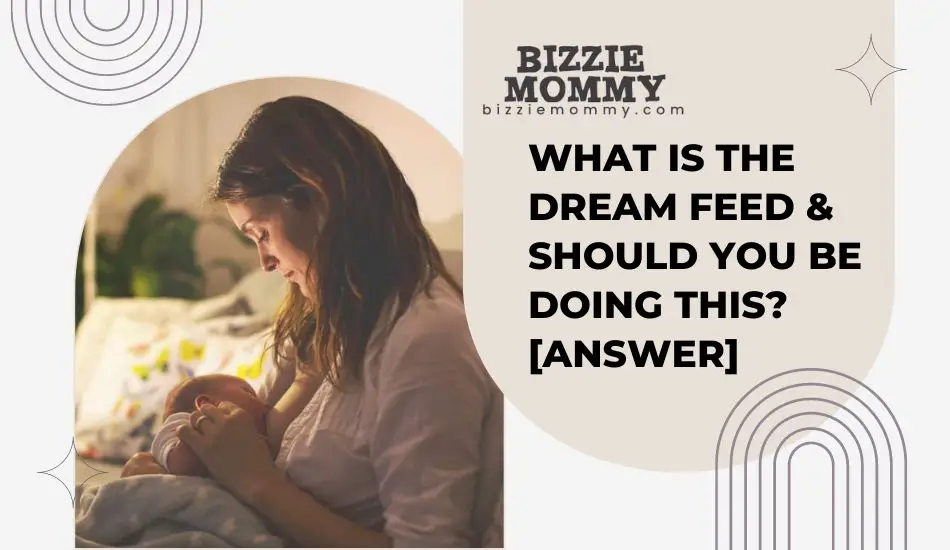You’ve heard your friends use this term for some time, or you’ve managed to conquer sleep regressions for the sneaky monsters they are, but you often come across this word and are curious about what dream feeding means.
While you are adjusting to your little one’s sleeping hours, you might be worried about their sleep as your baby wakes up multiple times during the night for a feed.
You might’ve come across the infamous dream feed and are curious. You’re at the right place! Here’s all you need to know about a dream feed and if it’s okay to try it.
Simply put, a dream feed is feeding your baby while they are sleeping. Feeding a sleeping baby can work for young babies up to 6 months of age. Most parents tend to dream feed their babies at around 11 pm so that they can have a longer stretch of sleep onwards through morning.
Let’s deep dive into this and see what dream feeding is and how it helps.
What is Dream Feed and How Does it Work?
As you finish putting your baby to sleep for the night, you know they’ll be up in a few hours for the next feeding.
When you head to sleep yourself, you might as well get your baby to take a feed. This is where dream feeding comes into play.
A dream feed is a late-night feeding that you can give your baby once you’ve put them to sleep, around 1-3 hours after bedtime. This extra feed is given by many parents to help their babies sleep longer through the night.
Parents tend to do this when they go to sleep themselves to make sure their baby gets a good long stretch of sleep at night and does not wake up in the middle of the night due to hunger.
By dream feeding your baby, you feed them while they are sleeping, just when you are about to hit the bed. This works not only for the baby but also helps parents get to sleep longer.
Dream feeding addresses one of the major causes of frequent night waking. Sneaking in an extra feed might delay the next feed, and both you and your baby can get a longer stretch of sleep at night.
As your baby sleeps, they go through different phases, including deep sleep and light sleep. Most babies experience sleep regressions due to hunger during light sleep.
To avoid these night wakings, you can give your baby an extra feed 3-4 hours after they’ve fallen asleep. This works for both breastfed and bottle-fed babies.
When Can You Start Dream Feeding?
Owing to their small stomachs, newborn babies require a feeding every 2 hours or so, so dream feeding is not recommended at the newborn stage.
Newborns’ sleeping patterns are generally unpredictable, so the idea of sneaking in a dream feed is surely out the window. Most experts suggest starting dream feeding once your wee one is a little older.
Once your baby can stay asleep for more than 4 hours after feeding, they might be ready for this new chapter.
For most babies, this time varies and might fall anywhere from 8 weeks to 4 months of age.
Keep in mind, age itself does not indicate that your baby is ready for dream feeding. It is more important to keep an eye on their feeding habits to determine readiness.
You might start dream feeding once your baby can sleep more than 3 hours without a feed. But it’s okay if you’re late to the party; better late than never!
You might be wondering when exactly you can stop dream feeding. Well, most parents prefer stopping once they’ve noticed that their little one can sleep for 11 hours straight without feeding.
Is Dream Feeding a Good Idea?
Wondering if it’s a good idea or not? Imagine after a long, tiring day with your wee one, you finally put your sweet baby to sleep.
After a few hours, you are just about to doze off when suddenly you hear your little one crying out in the room next door, ready for their night feed.
Just a few hours into your “me time” and you find your little one up and awake, hungry and grumpy! As much as we all absolutely adore our babies, we all deserve some rest at the end of the day.
For exhausted parents, dream feeding is a good alternative to night feeding. Unlike most of the time when you feed your baby, during a dream feed you’ll end up initiating feeding yourself.
If you’re worried about your little one’s sleep or about their health, dream feeding is an ideal option for you.
Can You Dream Feed a Breastfed Baby?
Dream feeds are initiated by the parents and can be done for children that are breast or bottle-fed. For most babies, the best time to start dream feeding is once they’ve crossed the newborn benchmark and have no trouble staying asleep for at least 4 hours after feeding.
Whether you are feeding breastmilk or bottle feeding your little one, dream feeding might help both you and your baby sleep longer.
Is Dream Feeding Good for Your Baby’s Sleep?
The real question is, are dream feeds good for your baby? Here are some reasons why you should consider dream feeding:
Help Your Baby Sleep Longer
If it isn’t obvious already, dream feeding might help your baby sleep for longer stretches of time at night by reducing wakings.
Sets a Consistent Schedule
Making it possible for your baby to sleep for longer periods at night might help their little internal clocks learn the adult ways and help reprogram the sleep wiring to that of an adult.
This helps you set a schedule for your little one by setting a bedtime as well as dream feeds.
Less Exhaustion
Missing those good ol’ days of content sleep? Dream feed to the rescue! It lets your baby sleep longer and helps you spend more time in your bed to get recharged for the new day ahead!
When to Drop Dream feeding?
Dropping dream feeds might seem like a task, but it isn’t. Here are some signs to look for if you think your little one is ready to drop the dream feed:
Less Frequent Feedings
If your baby doesn’t get up for feeding multiple times throughout the night, then a dream feed might be interfering with their sleep.
Baby Can Sleep Through the Night
If your baby requires feedings multiple times at night and is disturbing both their sleep and yours, then they might not be ready. Try to make sure your little one gets their calories throughout the day. Check their weight once in a while.
Baby Can Sleep for a Longer Stretch of Time
If your little one can easily stay asleep without a dream feed over two weeks’ time, then they might be ready for a transition.
Old Enough to Drop
Consider dropping if your baby is old enough to survive without eating for the whole night. For most babies, this age lies anywhere between 3 to 7 months of age.
Dream Feed is Interfering with Sleep
If your baby no longer gets up for late-night feedings, they might be disturbed by a dream feed. Try to drop it once to see if they have trouble staying asleep or not.
Other dream feeding pros include avoiding sleep regressions and extreme fussiness due to disturbed sleep.
How To Drop Dream Feeding?

Finally, it’s time to say goodbye to the dream feed but you’re unsure how to drop it. Well, we’ve gathered all that you need to know on how to drop dream feeding.
Here are some ways that can help you drop dream feeding:
Move Dream Feed Closer to the Last Feeding
The closer you move the dream feed to the last feeding, the more your baby will get used to staying asleep for longer periods without feeding.
You can try this by slowly bringing it closer to the last feed by 15 minutes every night. Make sure your baby is ready and the transition is slow.
Drop It Abruptly
Dropping it cold turkey might seem like a good option, but make sure your baby is fully ready to let go of their dream feed. Keep an eye out for any weight loss or check in with your doctor to make sure your baby is getting the nutrition they need during this change.
Decrease the Amount of Dream Feed
Gradually decreasing the amount of milk or formula that your baby drinks during the dream feed might help your baby smoothly transition out of this phase. But make sure to adjust your baby’s feeding schedule so they get their nutritional needs fulfilled and get enough food throughout the day.
When Should You Not Do Dream feeding?
While it seems as if dream feeding is an ideal option for most parents, there are a couple of reasons why you might drop the idea of dream feeding your baby.
Generally, it is not recommended to feed your baby if they are asleep or on their backs. This means it’s important to avoid feeding your baby if they are sound asleep. Try to partially wake them up to make nursing easier.
Overfeeding
Your baby might get used to an extra feed at night, so make sure you keep a check on that. Do not feed your baby if they seem disinterested once you wake them up.
Gassy Baby
Dream feeds might increase the amount of air swallowed by your baby, resulting in a gassy baby at night.
Sleep Regressions
Dream feeding might end up disrupting your little one’s sleep schedule, resulting in frequent night wakings and fussiness.
Why Should I Drop Dream-feeding My Baby?
Dropping dream feeding is an option only if your baby is ready for this transition. For most babies, this occurs around 6 months of age, when they can pull off a whole nighttime sleep without any feed.
You can consider dropping dream feeds if your baby is old enough to sleep 10 hours without feeds in between. If your child doesn’t wake naturally throughout the night asking for feeds, they might be ready for the drop.
If your baby has sleep regression and doesn’t fall asleep easily, then waking them up might seem like a bad idea. To help your baby get uninterrupted sleep, you might drop those dream feeds for now.
Final Thoughts On Dream Feeding
If you are worried about your little one’s sleep, as they wake up frequently at night out of hunger, you might want to try dream feeding your child. A dream feed is an extra feed that parents give 2-3 hours after their baby sleeps.
Dream feeds might help your baby sleep longer stretches during the night, making sure you get the sleep you need.
While feeding a sleeping baby might not exactly be what most parents advise, dream feeds work by pre-feeding your baby before they ask for it in the middle of the night.
Parents can start dream feeding at any age from 0-6 weeks, and most children stop at around 6 months of age when they can sleep without night waking.
Dropping the dream feed might be a challenge for parents, but reducing the duration of the feed or moving the time of the feed closer to the last feed might help your baby transition out of this phase smoothly.
It is essential to consult your doctor if your child has trouble gaining weight or experiences other related symptoms, for there might be an underlying condition disturbing your child.

